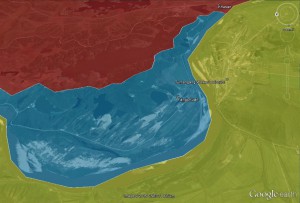UPDATE 1 (2015-4-4): For the second time this year, the Chinese have rejected a shipment of North Korean coal. According to the Korea Herald (Yonhap):
China has returned a shipment of anthracite coal to North Korea because it failed to meet standards for mercury emissions, according to a local report on Saturday.
This appears to be the second rejection by China of the North Korean mineral this year.
The shipment arrived at the Longkou port of China’s northern coastal province of Shandong late last month, but was returned as its quality did not satisfy China’s environmental regulations, iQiru.com, a local Shandong Internet news site, reported, citing an unnamed Longkou port official.
The report did not elaborate further or include the volume of the rejected North Korean coal.
…
In September last year, China announced strict regulations against the sale and import of coal with high toxic pollutants, including mercury and sulfur, to improve the country’s air and water quality.
Anthracite coal accounted for 39.8 percent of North Korea’s total exports to China last year.
China’s imports of North Korean coal plunged 53.2 percent from a year earlier to 16.78 million tons in January this year, according to Chinese customs data.
ORIGINAL POST (2015-3-9): Back in October of 2014, Kevin Stahler was the first person to point out (as far as I am aware) that the DPRK’s coal exports to China were in decline. Quoting Kevin:
However, this year North Korea’s anthracite exports to China are on course for a hard landing. The total value of imported anthracite is down 23 percent in the first half of 2014 compared to a year earlier. That’s an annualized $340 million hit to North Korea’s balance of payments. But North Korea is not alone: China has seen a double-digit decline in both the value and volume of its total world coal imports from January – August 2014.
On March 4, 2015, Yonhap reported that China returned a shipment of coal to the DPRK for reasons related to domestic environmental protection regulations:
China has rejected imports of some North Korean anthracite coal because the coal failed to meet domestic standards for mercury emissions, a local newspaper reported Wednesday, in what appeared to be China’s first rejection of North Korean minerals over environmental concerns.
The shipment was returned to North Korea on Feb. 27 from the Rizhao port of China’s northern coastal province of Shandong, the National Business Daily newspaper reported, citing an unnamed port official.
The report did not elaborate further, or include the volume of the rejected North Korean coal.
After three decades of rapid industrialization, China regularly sees hazardous air pollution with levels of particulate matter rising to nearly 40 times the limits set by the World Health Organization during the winter months.
In September, China announced strict regulations against the sale and import of coal with high toxic pollutants, including mercury and sulfur, to improve the country’s air and water quality.
Anthracite coal accounted for 39.8 percent of North Korea’s total exports to China last year.
In January, China’s imports of North Korean coal plunged 53.2 percent from a year earlier to 16.78 million tons, according to Chinese customs data.
On March 9, UPI reported on one of the key aspects of China’s new environmental policies and how it will affect the DPRK:
China’s crackdown on coal-related pollution will take a heavy toll on the North Korean economy, South Korean newspaper Donga Ilbo reported Monday.
China’s plan is to drastically reduce coal consumption by 160 million tons in the next five years. The plan, presented at the National People’s Congress in Beijing, aims to reduce the fossil energy use that is contributing to severe pollution in big cities, The Australian reported.
Countries exporting coal to China are all affected, but the plan could create an economic crisis in impoverished North Korea. Coal and iron-ore exports are two of North Korea’s biggest exports to China, its biggest trading partner.
According to the Donga Ilbo, more than 97 percent of North Korean exports are shipped to China*, and coal, iron ore comprise 60 percent of all North Korean exports.
China’s anti-pollution policy is affecting North Korean cargo. A North Korean ship delivering coal to China was turned away at the coastal city of Rizhao on Feb. 27. The Donga Ilbo reported the coal did not satisfy China’s environmental regulations.
The rising ban and other factors are placing the impoverished North Korean economy in a tight squeeze.
Anna Fifield also covered this story for the Washington Post and Guardian.
*The article reports that China accounts for 97% of the DPRK’s international trade. This is only true if one excludes South Korean trade–which South Korea does because they consider North-South trade as “inter-korean” trade.

